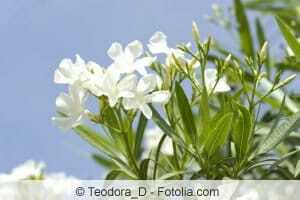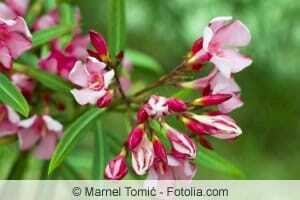

Table of contents
- Yellow Aphid
- damage
- home remedies
- crop protection products
- Neem based pest control
- plant protection sticks
- Special chemical pesticides
- predators
- toleration
- Conclusion
Once you spot aphids on the oleander, you have to act quickly. Because no matter what kind of aphid it is, they all multiply explosively. Because of their special fondness for oleander, the yellow aphids are also called oleander aphids. Perfect location and care conditions for the oleander can reduce the risk of infestation but rarely prevent it entirely. Therefore, an important additional care measure should be to regularly examine the oleander for a possible infestation in order to be able to tackle it as early as possible.
Yellow Aphid
Together with the Mediterranean oleander, the yellow aphid also conquered Central Europe. She specializes in plants from the Apocynaceae (dogbane) family. The Aphis nerii (oleander aphid) belongs to the family Aphidoidea (aphids) from the suborder of plant lice (Sternorrhyncha). The yellow aphid is one of over 800 species native to Central Europe alone. With their yellow color they give a warning to all predators. They can also secrete a toxic secretion, cardenolide (cardiac glycosides), to defend themselves. They get their color and chemicals from the plant sap from the dogbane plants, i.e. our oleander. This poison leads to deformities or disturbed behavior in many predators. Whether and how strong the poison affects the enemies depends on the respective concentration of the poison in the plant. If it is too low, even the living aphids become victims of lacewing larvae, ladybugs and spiders. There are only female aphids, they reproduce by parthenogenesis (virgin procreation, by clones of the mother). As soon as a host plant is overcrowded or stressed by enemies, the aphids secrete certain scents (pheromones). These provide the incentive to give wings to the next generation of aphids. These can then look for new plants in a new environment.
damage
Like all aphids, yellow aphids feed on the sap of the plant. The high proportion of carbohydrates in the plant sap cannot be utilized by the aphid. They excrete it as so-called honeydew, a sugary solution. This sticky substance attracts other insects and is also an ideal breeding ground for fungi and viral diseases. Most of the time, the greatest damage to the plant is not caused by the aphids themselves, but by a subsequent infestation of fungal diseases and plant viruses. Wasps, bees and ants use this honeydew as a food source. The ants even enter into a special form of symbiosis with the lice and thus support their spread. Similar to our livestock farming. First you discover the lice on the undersides of the leaves, as well as on young buds and leaf shoots. Shoot tips and leaf axes are wetted with a sticky secretion. This leads to discoloration of the leaves, which later curl up. The flowers form deformations, shoot anomalies arise. The honeydew favors the colonization of sooty mold and the dangerous sooty mold.
home remedies
Most of the time, an infestation with aphids can be kept in check with home remedies. completely eliminate. Means for spraying the affected areas and with good effect are:
- tobacco brew
- nettle brew
- soft soap
- detergent
- stone flour, wood ash
A soapy solution as a spray is made as a 2% solution of soft soap, curd soap, or washing-up liquid and water. This is used to spray the affected areas over several days. This is the first remedy that can be used immediately in the case of a mild infestation. For the production of tobacco stock, you boil approx. 50 g of tobacco pure or from cigarette butts in one liter of water and filter the brew through a cloth. An additional addition of soapy water has proved its worth. Approximately 500g of nettle in 5 liters of water are used for a nettle brew. Leave both in a bucket for 1 to 2 days, then pour off the brew.
Tip:
Nettle and tobacco stock can also be added to the irrigation water. They act there via the roots on the sap in the upper parts of the plant against the aphids.
Stone dust or wood ash is sprinkled on the infested area to suffocate the lice. After that, the plant must be cleaned. For a lasting effect, the plant should always be cleaned of the sticky liquid as thoroughly as possible with clear water. Repeated applications of the above home remedies over a long period of time are definitely necessary to prevent further infestation.
crop protection products
If the infestation of aphids is already very advanced and all home remedies have failed, it can it may be necessary to use pesticides to protect the precious oleander rescue.
Neem based pest control
There are various finished preparations made from the active ingredient of the neem tree to buy. If you want to be sure that you are fighting the pests with the pure natural product of the neem tree, you can make a mixture of pure neem oil and water yourself. Cream or milk can be used as an emulsifier. Example recipe: Mix 2 tablespoons of neem oil in half a cup of lukewarm cream or milk and then mix with 1 liter of water. The remedy should then be sprayed onto the infested areas daily until all lice are gone. The remedy stops any further development of the aphids. When added to the irrigation water, it has a time-delayed, systemic effect on the sap that the aphids suck via the roots of the plants.
plant protection sticks
Inserted into the pot, special plant protection sticks or cones act on the aphids via the roots of the plants. These can help when the infestation begins or can also be used as a preventive measure.
Special chemical pesticides
Chemical agents against aphids should only be used in emergencies. Although they help in almost every case, they are always a danger to the useful insect world. They should not be used on flowering plants in particular, so as not to harm the bees in particular.
Tip:
If you can no longer fight a severe infestation of your precious oleander, you could also give the tree to a nursery for treatment. Here one has the approval for the use of toxic substances that are not available for the end user.
predators

Aphids have natural enemies, including ladybirds, ladybird larvae, hoverfly and lacewing larvae, various beetles, spiders and birds. Especially with the yellow aphids, these are sometimes more sometimes less successful. Ladybug larvae and lacewing larvae are available in specialist shops, but may fail due to the yellow aphid due to their poison.
toleration
Yes why not? This not only seems to be a very convenient solution, but also a very natural "non-control measure". However, this method is only recommended if the oleander is in a relatively adequate environment. Neither in the pot on the summer terrace nor in the winter garden is there the appropriate environment to ensure a natural balance by itself. A biotope in which neither the plant nor the lice or predators can be seriously harmed. However, if someone has an oleander tree in the garden of their Spanish holiday home, this measure is definitely worth considering.
Conclusion
In our latitudes, the oleander is not exactly an easy-care, everyday plant. Anyone who successfully makes it grow and bloom over several years will always try to keep pests and diseases away from it. A regular inspection for a pest infestation is just as important as adequate control measures, for example in the case of an infestation with the yellow aphid.
 garden editorial
garden editorial I write about everything that interests me in my garden.
Learn more about pests

Ants in the raised bed: what to do?
If ants are found in the raised bed, quick action is required. With the right means and measures, however, the insects can be easily controlled or driven away.

Fight vine weevil: 6 home remedies
The vine weevil is only a problem in the garden when it occurs in large numbers. The beetle eats the leaves, the damage to the larvae is much greater. They eat at the roots and can also cause plants to die off.

Big holes in the garden: which animal was it?
Whether in the lawn or "just" in flower beds, holes in the ground make no gardener happy. But who causes the holes? And how do you get rid of them? We explain causes and strategies for annoying visitors underground.

Combat Little Red Spider | 7 tips for garden & balcony
Although the little red spider is harmless because it neither stings nor transmits diseases, its occurrence is still a thorn in the side of many people. The little creatures become particularly annoying when they are not just limited to infesting plants, but also spread out on the balcony or even in the apartment. Fortunately, effective biological measures exist to control the arachnids.

Rats in the garden: what to do? How to fight the plague of rats
Many people are disgusted just at the thought of rats: after all, the harmful rodents have been considered carriers of dangerous diseases for thousands of years. The animals also cause considerable damage in the house and in the garden. This is how you get rid of the plague again - sustainably and effectively.

Ultrasonic Rat Control – Does Ultrasound Help Against Pests?
Rats in the house or in the garden are not only disgusting, they can also quickly become a problem. But what can you do about it? Ultrasonic rat control is often recommended. However, the method is very controversial. More about this is here.

